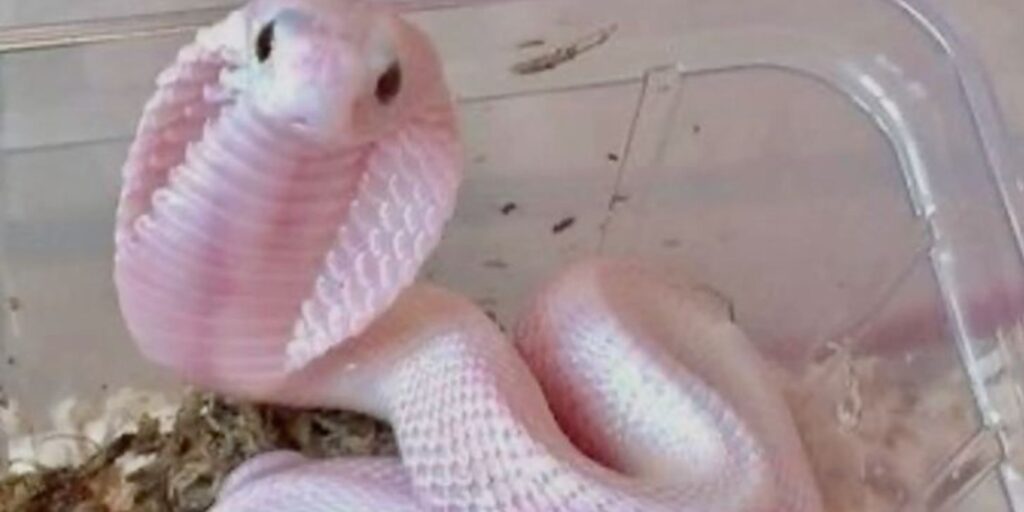Introduction
Albino snake captivate the imagination like few other creatures. Their striking appearance, with ghostly white scales and vivid red or pink eyes, evokes a sense of mystery and wonder. But what lies beneath this enchanting exterior? Albinism is a fascinating genetic phenomenon that has given rise to some of nature’s most intriguing animals. Albino snakes are not just beautiful; they embody unique traits shaped by their environment and biology. Join us as we delve into the world of albino snakes, explore their allure, and uncover the secrets behind their existence in the wild and captivity. Get ready to be mesmerized by these extraordinary reptiles!
The Enigmatic Beauty of Albino Snakes: Nature’s Albinism Explained
Albinism is a genetic condition that causes the absence of melanin, the pigment responsible for the color of skin, hair, and scales. In snakes, this can lead to stunning variations that differ drastically from their more common counterparts. The result? a mesmerizing creature with an ethereal presence.
Albino snakes can be found in various species, including pythons and boas. Their lack of pigmentation makes them stand out strikingly against natural backgrounds. While they may look fragile or delicate due to their pale appearance, these reptiles possess remarkable survival adaptations.
Nature’s albinism also contributes to the ecosystem’s balance. Although albino snakes are often more vulnerable to predators because of their visibility, they showcase how diversity within species contributes to nature’s tapestry.
These unique beings challenge our perceptions and remind us that beauty comes in many forms. Whether basking under sunlight or slithering through foliage, albino snakes encapsulate intrigue and allure like few other animals on Earth.
Albino Animals in Nature

Albino animals are fascinating and rare sightings in the wild. Their striking white or cream-colored bodies stand starkly against natural backdrops, making them beautiful and vulnerable. Albinism occurs due to a genetic mutation that disrupts melanin production, creating this unique coloration.
While albinism can be found across various animal species, snakes exhibit some of the most captivating examples. An albino snake’s bright scales shimmer under sunlight, creating an almost ethereal presence among its peers. However, this beauty comes with challenges for survival.
These creatures often struggle with predation due to their lack of camouflage. Brightly colored predators may easily spot them against the foliage or ground cover. Furthermore, they face increased risks from environmental factors like sunburn since their skin lacks protective pigmentation.
Despite these hardships, albino animals remind us of nature’s diversity and complexity. Each sighting offers a glimpse into the rich tapestry of life on Earth and highlights how variations can impact survival differently.
Understanding Albinism in Snake
Albinism in snakes is a fascinating genetic condition. It results from a mutation affecting melanin production, giving these reptiles striking white or yellow coloration. This absence of pigment can make them stand out dramatically against their natural surroundings.
The specific genes involved in this process are complex. When both parents carry the albino gene, offspring may inherit it. The result is an enchanting snake with vibrant colors and unique patterns, lacking the usual black or brown hues.
Albino snakes can be found across various species, including ball pythons and corn snakes. Each type possesses its distinct beauty, captivating reptile enthusiasts and casual observers alike.
While albinism offers stunning visual appeal, it comes with challenges, too. Due to the lack of pigmentation, these snakes often have sensitive skin and reduced eyesight. Understanding these nuances helps us appreciate their beauty and the care they require in captivity.
The Fascination with Albino Snake

Albino snake captivate the imagination of many. Their striking appearance sets them apart from their more colorful relatives. With a pure white body and vibrant red or pink eyes, they evoke curiosity and awe in anyone who encounters them.
The rarity of albino snakes adds to their allure. Albinism occurs due to a genetic mutation that prevents pigmentation, making these creatures unique in the wild. This unusual trait often leads enthusiasts and researchers on quests to learn more about their biology and behavior.
Many collectors seek out albino snakes for their beauty, showcasing them at expos or as part of breeding programs. The demand has led to a growing market for exotic pets, with breeders carefully selecting parents to produce stunning offspring.
Beyond aesthetics, these animals are surrounded by an element of mystery. People are drawn not just by how they look but also by the stories behind each snake’s survival journey in the natural world despite its visibly different appearance.
Albino Snake in Captivity
Albino snake have captured the interest of reptile enthusiasts around the globe. Their striking appearance and unique characteristics make them particularly sought after in captivity. Breeders often focus on producing these captivating creatures, resulting in various morphs that showcase their beauty.
When kept as pets, albino snakes require specific care to thrive. A suitable habitat mimics their natural environment with proper temperature gradients and humidity levels. Providing hiding spots is essential since these snakes are naturally secretive.
Feeding habits also play a critical role in their health. They typically consume rodents, which should be appropriately sized for the snake’s age and size. Regular feeding schedules contribute to their growth and overall well-being.
Health monitoring must also be noticed. Routine vet check-ups ensure any underlying issues are addressed promptly. With dedicated care, albino snakes can live long lives while enchanting their owners with every mesmerizing scale they possess.
Care and Maintenance of Albino Snake
Caring for an albino snake requires attention to specific needs. Their unique light coloration makes them more susceptible to sunburn, so providing a shaded area in their habitat is crucial. A well-structured enclosure with plenty of hiding spots will help your snake feel secure.
Temperature regulation is vital for these reptiles. Maintain a warm side between 80-85°F and a cooler side at about 75°F. This temperature gradient allows your albino snake to regulate its body heat as needed. Use appropriate heating elements while ensuring no hot spots could lead to burns.
Feeding an albino snake should be done with care, too. Like any other species of snake, a diet primarily consisting of appropriately sized rodents works best. Monitor their eating habits closely; if they refuse food consistently, it might indicate stress or health issues.
Regular cleaning of their enclosure helps prevent bacterial growth and keeps the environment healthy. Routine humidity level checks can also ensure optimal living conditions for your pet’s well-being.
The Myth and Reality of Albino Snake

Albino snakes often evoke a sense of mystery and wonder, but myths surround them. One common misconception is that all albino snakes are blind. While they have reduced vision compared to their colored counterparts, they can still see well enough to hunt and navigate their environment.
Another myth suggests that albinism significantly affects an animal’s health. In reality, many albino snakes live healthy lives in the wild and in captivity. Their unique coloration doesn’t inherently make them weaker or more prone to disease; however, it can affect their survival rates due to increased visibility to predators.
People sometimes think these stunning creatures are purely artificial due to selective breeding. Although captive-bred albino varieties like the ball python are popular, albinism occurs naturally in several species worldwide.
Their rarity also fuels the fascination with albino snakes. Finding one in nature can feel like spotting a hidden treasure among its vividly colored peers—a marvel of genetic variance waiting to be appreciated.
Appreciating the Unique Characteristics of Albino Snake
Albino snakes are a remarkable testament to nature’s diversity. Their striking appearance captures the imagination and invites awe from wildlife enthusiasts and casual observers alike. The absence of pigmentation creates a visual spectacle, showcasing unique patterns that differ among species.
These snakes often display vibrant hues that stand out against their white or cream backgrounds, making them easily recognizable. This captivating beauty is not solely for aesthetic appreciation; it also speaks volumes about nature’s ability to produce variations within species.
Beyond their physical traits, albino snakes represent resilience. Despite facing challenges in the wild due to visibility and predation risks, they adapt uniquely within their environments.



